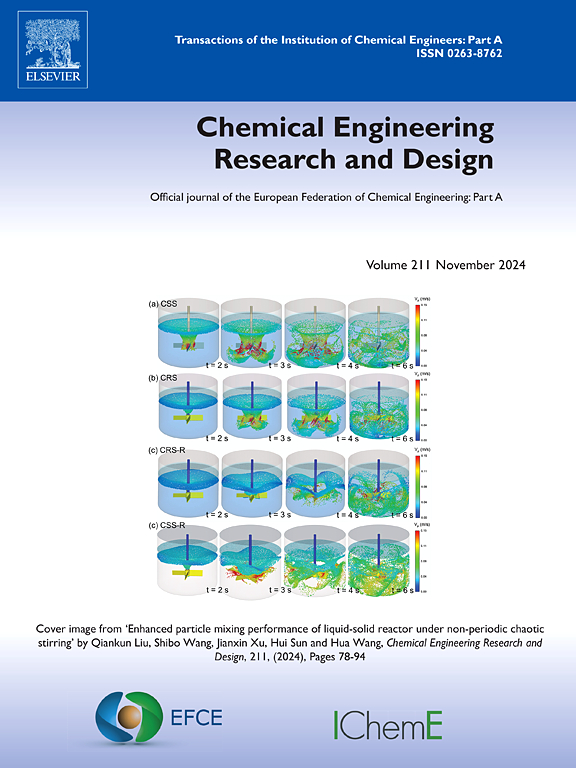Research on the mass transfer in gas-liquid flow of microchannels for CO2 absorption
IF 3.7
3区 工程技术
Q2 ENGINEERING, CHEMICAL
引用次数: 0
Abstract
Carbon capture technology has been recognized as an effective method for reducing greenhouse gas emissions. The experimental system utilizing monoethanolamine (MEA) solution in microchannel for the absorption of CO2 from a mixed gas was developed. The flow and mass transfer characteristics of Taylor bubbles in T-shaped microchannel during the absorption process were analyzed. Due to surface tension effect, Taylor bubbles could not fully occupy the corner of the channel, leading to the generation of leakage flow. To accurately describe the extent of leakage flow and correct the flow parameters, section coefficient was introduced as a correction factor, and equivalent leakage factor was proposed to directly characterize the proportion of leakage flow relative to the total flow. Quantitative analysis indicated that the degree of leakage flow increased with liquid flow rate. The results demonstrated that under conditions of liquid phase concentration C (MEA) = 10 wt%, liquid phase flow rate QL = 70 mL/min, and gas phase flow rate QG = 70 mL/min, the maximum CO2 absorption efficiency reached 96.36 %. Meanwhile, the mass transfer coefficient stabilized at 1.893 × 10−3 m/s, and the energy consumption for CO2 capture was only 2.272 MJ/ kg CO2.
CO2吸收微通道气液流动传质研究
碳捕获技术已被公认为是减少温室气体排放的有效方法。建立了利用微通道单乙醇胺(MEA)溶液吸收混合气体中CO2的实验系统。分析了t型微通道中泰勒气泡在吸收过程中的流动和传质特性。由于表面张力的作用,泰勒气泡不能完全占据通道的角落,导致泄漏流的产生。为了准确描述泄漏流量的大小并对流量参数进行校正,引入了截面系数作为校正因子,并提出了等效泄漏因子来直接表征泄漏流量占总流量的比例。定量分析表明,泄漏流动的程度随着液体流量的增加而增加。结果表明,在液相浓度C (MEA) = 10 wt%、液相流速QL = 70 mL/min、气相流速QG = 70 mL/min条件下,CO2吸收效率最高可达96.36 %。同时,传质系数稳定在1.893 × 10−3 m/s, CO2捕集能耗仅为2.272 MJ/ kg CO2。
本文章由计算机程序翻译,如有差异,请以英文原文为准。
求助全文
约1分钟内获得全文
求助全文
来源期刊

Chemical Engineering Research & Design
工程技术-工程:化工
CiteScore
6.10
自引率
7.70%
发文量
623
审稿时长
42 days
期刊介绍:
ChERD aims to be the principal international journal for publication of high quality, original papers in chemical engineering.
Papers showing how research results can be used in chemical engineering design, and accounts of experimental or theoretical research work bringing new perspectives to established principles, highlighting unsolved problems or indicating directions for future research, are particularly welcome. Contributions that deal with new developments in plant or processes and that can be given quantitative expression are encouraged. The journal is especially interested in papers that extend the boundaries of traditional chemical engineering.
 求助内容:
求助内容: 应助结果提醒方式:
应助结果提醒方式:


